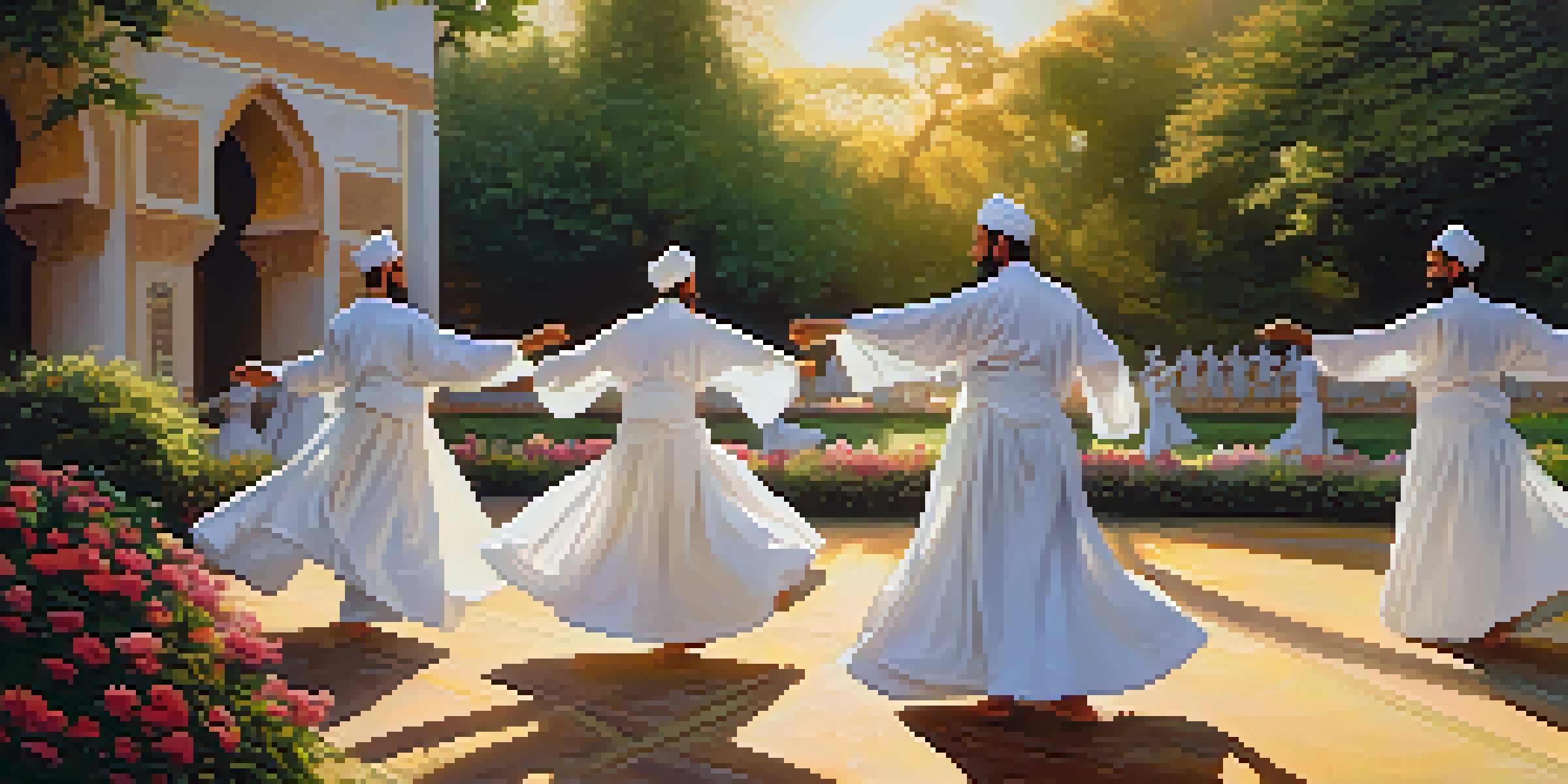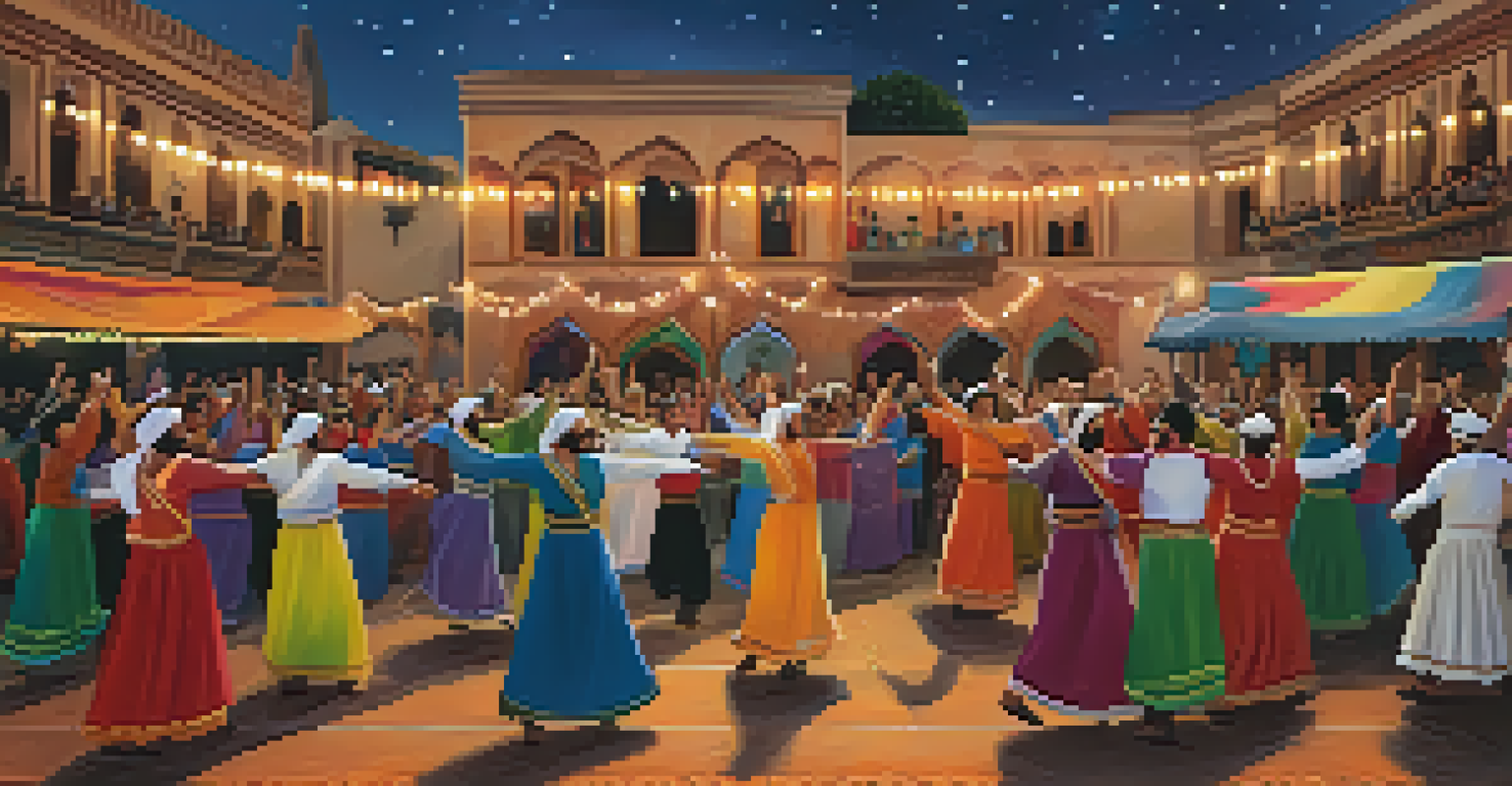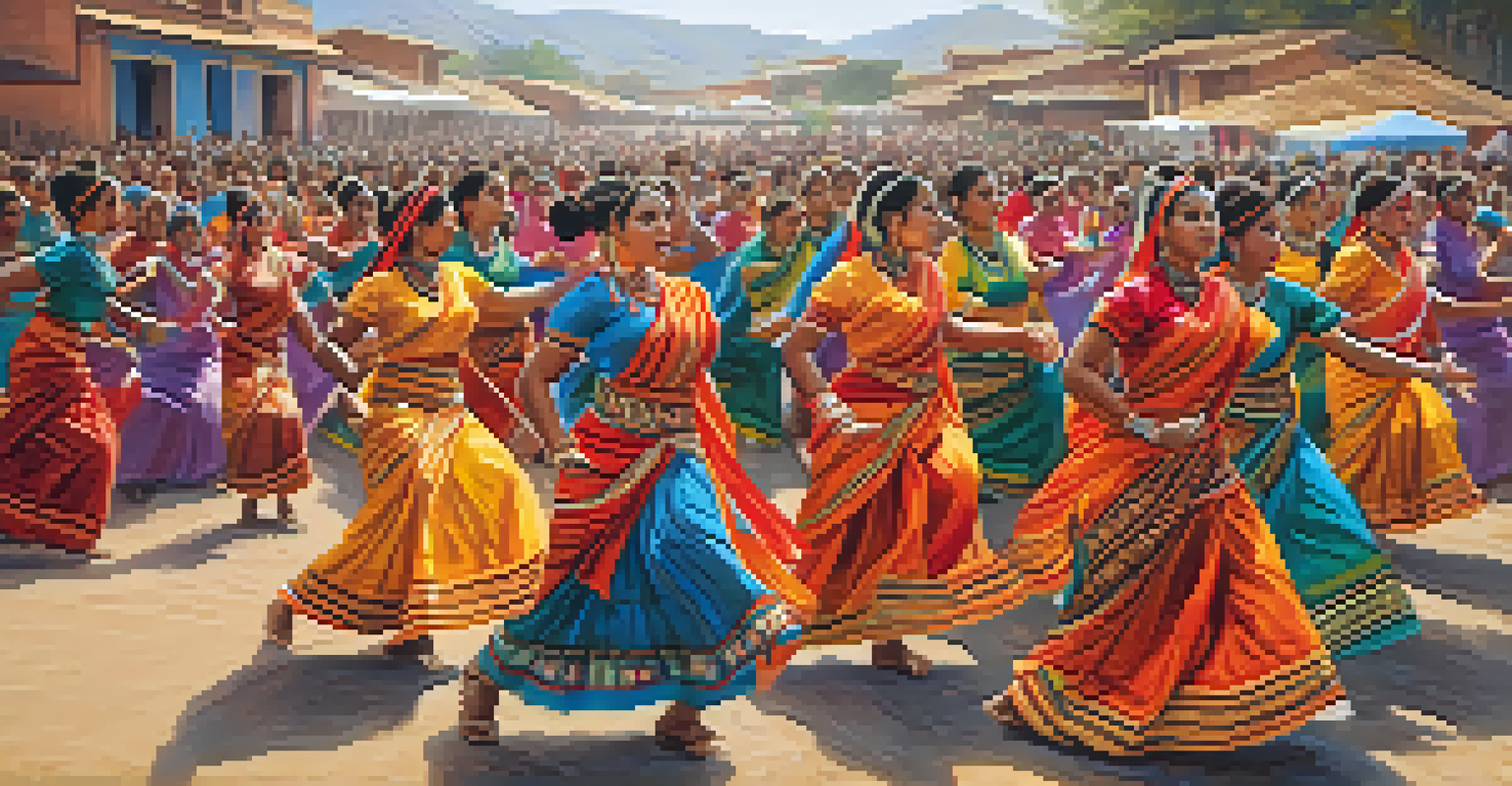Rituals in Motion: Dance Traditions in Islamic Worship

Understanding Dance in Islamic Contexts
Dance in Islamic worship might seem unusual at first glance, as many associate the faith with solemn rituals. However, throughout history, various forms of dance have played a significant role in expressing devotion and community spirit. These movements often reflect the culture and traditions of different Islamic societies, showcasing how dance can be a form of worship.
Dance is the hidden language of the soul.
In many Islamic cultures, dance serves as a means of connection to the divine, often incorporating spiritual themes. For instance, Sufi whirling, a form of physically active meditation, allows practitioners to experience a sense of unity with God. This highlights how dance transcends mere entertainment, becoming a profound expression of spirituality.
Moreover, dance traditions can vary widely across different regions, each adding its unique flavor to Islamic worship. From the vibrant folk dances of North Africa to the graceful movements in South Asian rituals, these practices illustrate the rich tapestry of Islamic culture and the diverse ways people express their faith through movement.
Sufi Whirling: A Dance of Devotion
Sufi whirling is one of the most recognized forms of dance within Islamic worship, particularly associated with the Mevlevi order. This mesmerizing practice involves spinning in circles while maintaining a state of spiritual focus, symbolizing the soul's journey toward God. The whirlers, dressed in white robes, create a beautiful visual representation of the quest for divine love.

The act of whirling is not just physical; it embodies a profound spiritual experience. Practitioners believe that as they spin, they shed their earthly concerns and connect more deeply with the divine presence. This practice emphasizes the importance of surrender and trust in God, turning the act of dancing into a moving prayer.
Dance as Spiritual Expression
Dance in Islamic contexts serves as a profound expression of spirituality, allowing worshippers to connect with the divine through movement.
Sufi whirling has transcended borders and cultures, often captivating audiences worldwide. Its unique blend of spirituality and artistry serves as a reminder of how dance can facilitate a deeper understanding of faith, making it a powerful tool for both worship and personal expression.
Cultural Variations in Dance Practices
Islamic dance traditions are as diverse as the cultures that practice them, each contributing unique elements to worship. In Indonesia, for instance, the Saman dance is performed during religious events, characterized by rhythmic movements and clapping, celebrating community and spirituality. This dance not only entertains but also serves as a form of collective prayer.
The body says what words cannot.
Similarly, in the Middle East, the traditional folk dance known as the 'Dabke' brings communities together, often performed at weddings and religious festivals. This energetic line dance emphasizes unity and joy, reflecting the communal aspect of worship in Islamic culture. These dances illustrate how physical movement can reinforce social bonds while celebrating faith.
Through these various cultural expressions, we see how dance serves as a universal language of worship. Each tradition honors the shared values of devotion, community, and celebration, illustrating the ways in which dance can foster a sense of belonging and connection among worshippers.
Dance as a Form of Prayer
In many Islamic communities, dance is not merely an art form; it is viewed as a legitimate form of prayer. The movements and rhythms can serve as a means of expressing love and gratitude towards God. This perspective allows participants to engage their bodies in worship, creating a holistic approach to spirituality that encompasses mind, body, and soul.
For instance, in some Sufi practices, participants engage in rhythmic dance as a way to enter a meditative state, enhancing their focus on prayer. This physical engagement helps practitioners to channel their emotions and intentions, fostering a deeper connection with the divine. It's a beautiful reminder that worship can take many forms, including the expressive movements of dance.
Cultural Diversity in Dance Practices
Islamic dance traditions vary widely across cultures, each adding unique elements that reflect community and faith in diverse ways.
Ultimately, this integration of dance and prayer highlights the flexibility of spiritual practices within Islam. It challenges the notion that worship must be confined to structured rituals, illustrating instead that personal expression through movement can also be a valid pathway to connect with God.
The Role of Community in Dance Rituals
Community plays a vital role in Islamic dance traditions, as these practices often bring people together in shared worship. Dance rituals can help strengthen communal bonds, fostering a sense of belonging among participants. This collective experience can be especially powerful, as it reinforces the idea that worship is not just an individual act but a shared journey.
In many cultures, dance is performed during significant religious celebrations, such as Ramadan or Eid. These gatherings create opportunities for families and friends to come together, sharing in the joy of worship through dance. Such events highlight the communal aspect of faith, where the act of dancing becomes a symbol of unity and shared devotion.
Moreover, these communal dance practices can serve as educational tools, passing down cultural and religious values through generations. As younger members participate in these rituals, they learn about their heritage and the importance of community in their spiritual lives, ensuring that these traditions continue to thrive.
Women in Islamic Dance Traditions
The role of women in Islamic dance traditions is significant and multifaceted, often reflecting broader societal values and norms. In many cultures, women participate in dance as a means of expressing their faith and celebrating their identities. This involvement can empower women, allowing them to take an active role in religious and cultural expressions.
For example, in some African and Middle Eastern cultures, women engage in traditional dances during festivals and religious ceremonies. These performances often hold deep spiritual significance and provide a platform for women to showcase their talents and creativity. Through dance, they not only honor their faith but also assert their presence within their communities.
Role of Community in Dance Rituals
Community plays a vital role in Islamic dance, fostering unity and shared worship during significant religious celebrations.
However, the participation of women in dance can also be complex, as cultural and religious interpretations vary widely. While some communities embrace women's dance as a form of worship, others may impose restrictions based on their understanding of modesty. This diversity showcases the rich dialogue within the Islamic world surrounding gender roles and expressions of faith.
The Future of Dance in Islamic Worship
As the world continues to evolve, so too do the expressions of worship within Islam, including dance. Contemporary artists and practitioners are finding innovative ways to incorporate traditional dance forms into modern worship settings. This blending of old and new not only keeps the traditions alive but also makes them relevant for younger generations.
Social media and global connectivity have played a crucial role in this transformation. Dance performances can now reach audiences far beyond their origins, creating a global appreciation for Islamic dance traditions. This exposure encourages dialogue and understanding, inviting more people to explore the spiritual dimensions of these practices.

Looking ahead, the future of dance in Islamic worship holds exciting possibilities. By embracing both tradition and innovation, communities can continue to celebrate their faith through movement, ensuring that dance remains a vital part of their spiritual expression for generations to come.